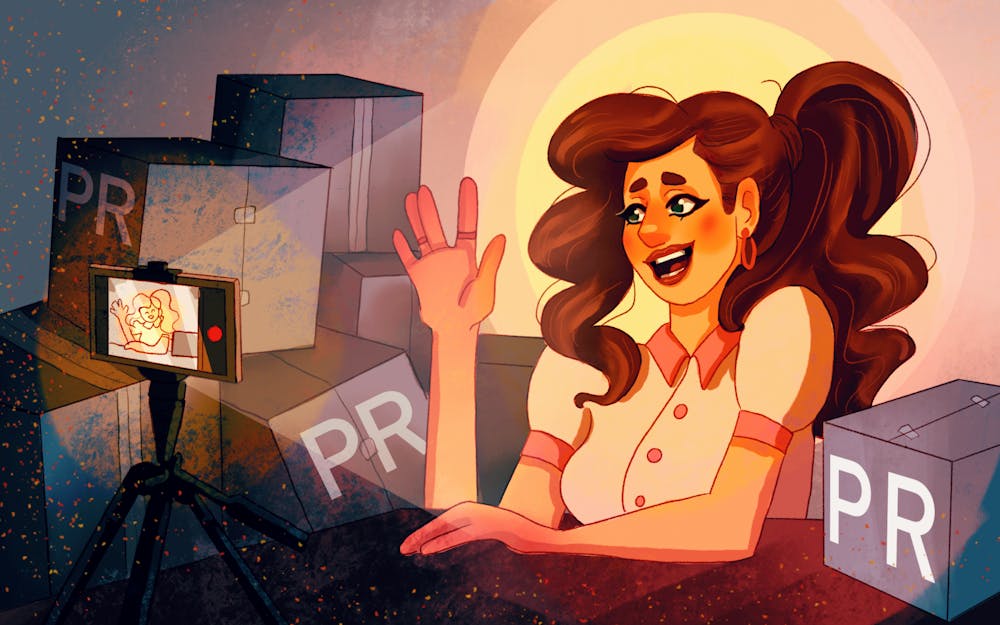Darcy McQueeny, a 21-year-old social media influencer and college student, stands next to a pile of amazon packages taller than her in a video posted last Friday titled “Massive Amazon Haul.” She boasts 1.2 million followers on TikTok as of Jan. 30.
“Everything can be found in my Amazon storefront in the recently bought list,” she explains in her video before opening the packages, which include products ranging from four different kinds of shaped ice cube trays to a makeup brush set.
“Haul” videos like this and young, female lifestyle and beauty influencers like McQueeny are common on TikTok and have dedicated audiences of similar demographics. Popular creators often have affiliate links, like an Amazon storefront, in their account bio.
Amazon, which generated $469.82 billion in revenue in 2021, created the storefront as part of their Amazon influencer program. The program allows social media creators with a significant following to advertise products across their accounts and direct followers to purchase said products on their Amazon storefront. When people buy from an influencer’s storefront, the influencer makes a commission. McQueeny’s page has categories such as “College Necessities” with 147 items listed and “Recently Bought” which has over 150 items listed.
It is not surprising to see this rise in companies using influencer marketing to advertise their products toward primarily young women, given that women have been shown to make between 70% and 80% of all consumer purchasing decisions, according to Forbes.
While consumption has undoubtedly been a central component of many Americans' lives since the Industrial Revolution, the age of social media, especially TikTok, is giving way to an unprecedented level. Influencers like McQueeny post hauls and “Get ready with me” videos, usually showing off the products they are buying or being sent through company PR. On McQueeny’s haul video, most commenters are supportive and relate to her about the products she shows that they also bought or want to buy.
According to the Wall Street Journal in 2019, Americans were purchasing five times more clothing per person than they did 40 years ago. Additionally, Americans purchase environmentally harmful things like flights and factory-farmed red meat at higher levels than those in other countries. The push to overconsume clothing, cosmetics, and household items that these influencers promote is exacerbating the devastating effects of climate change.
It cannot be ignored that the impacts of climate change and overconsumption, largely driven by wealthy countries like the U.S., tend to be felt the most by those living in historically exploited, less developed countries. Even within the U.S., it is those who are a part of the poorest communities who are most hurt by overconsumption habits. It is not globally sustainable for us to be consuming at such high levels.
Beyond the environmental impact of overconsumption is the increasing pressure it drives for young women living in a patriarchal, capitalistic society to achieve perfection. According to a 2016 Girls’ Attitudes study done in the UK, 61% of girls between the ages of 11 and 21 said they felt the need to be perfect, and 80% felt their looks were the most important thing about them. These feelings and vulnerabilities make young women and girls the perfect targets for aggressive marketing and advertising.
Preying on many women’s desires to be more beautiful, more feminine and simply more perfect, many companies advertise products for “problems” they created, usually pertaining to existing in one’s natural state. Take the fact that some girls are now shaving their faces with specialized facial razors to remove peach fuzz or the wide array of heavily scented intimate washes, lotions, perfumes and even period products available at your local drugstore. There seems to be no limit to how many products companies will push using the idea that women could always be doing more to improve their beauty and desirability.
As shown by the Amazon influencer program and other PR initiatives by brands, where they pay influencers to advertise, promote or even just display their products in social media pictures and videos, influencer marketing is expanding rapidly.
While this worrying trend of overconsumption being promoted through social media is certainly the fault of large corporations and the capitalistic pursuit of profit, those with consumption power, especially young women and girls, should be critical and thoughtful about which companies they support and which products they truly need to consume.
Leila Faraday (she/her) is a freshman studying policy analysis.






